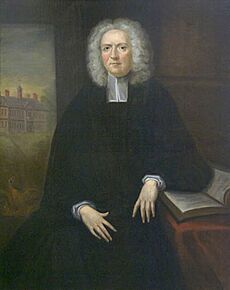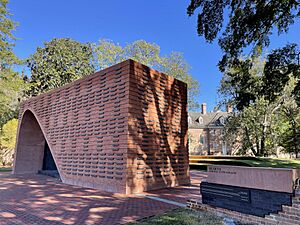- This page was last modified on 10 June 2025, at 21:58. Suggest an edit.
History of the College of William & Mary facts for kids
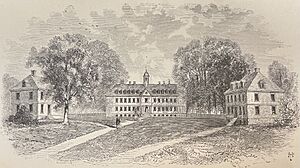
Print depicting Ancient Campus as it would have appeared before 1859. The Brafferton (left) and President's House (right) flank the Wren Building
The College of William & Mary started way back in 1693. It was created by a special paper from the King and Queen of Great Britain, called a "royal charter." This paper said the college would teach about religion, thinking, languages, and other good subjects.
Before this, people in the British Colony of Virginia had wanted a university like those in England, such as Cambridge and Oxford. They even tried to start one in a place called Henricus in 1618. A plaque on the college's first building, the Wren Building, says the idea for the college came from Henrico.
The college was named after the rulers at the time, King William III and Queen Mary II. Reverend Dr. James Blair, the first president, chose the college's spot. It was on high ground in a small town called Middle Plantation. A few years later, Dr. Blair and some students helped convince leaders to move the capital from Jamestown to Middle Plantation. In 1699, the town was renamed Williamsburg.
About 75 years later, during the American Revolution, the college changed from being supported by Britain. It added new programs like a law school. After the American Civil War (1861–1865), the college buildings and money were in bad shape. But presidents Benjamin Stoddert Ewell and Lyon Gardiner Tyler worked hard to get money from the U.S. government and Virginia. This helped fix the buildings and add new programs, especially for training teachers.
In 1918, William & Mary became the first state-supported college in Virginia to allow both women and men to study there. The college is also close to Colonial Williamsburg, a restored historic area. Students still go to Bruton Parish Church nearby, continuing a tradition that is over 300 years old.
Contents
- Early Ideas for a College
- Founding the College
- Colonial Times
- Changes After the Revolution
- Before the Civil War (1776–1861)
- Slavery and William & Mary
- Civil War and Becoming a State School
- 20th Century: Coeducation and Teacher Training
- Mid-1930s Through World War II
- After World War II to Today
- Sir Christopher Wren Building
- College Firsts
- Secret Societies
- See also
Early Ideas for a College
The first permanent English settlement in Virginia was Jamestown, started in 1607. It was a business idea to make money for England. The Church of England was closely tied to the government. Leaders in the colony wanted to teach the beliefs of the British Empire to the Native Americans. They thought teaching English and reading would help Native Americans become more like the English.
In 1618, a company in London ordered land to be set aside for a university in Henrico. This included a branch for Native American students. The goal was to create a school for both Native American young men and the sons of colonists. In 1619, money was collected for the college. The Virginia General Assembly, the colony's government, asked for workers from England to build it.
However, in 1622, there was an uprising by Native Americans. A leader named George Thorpe was killed, and Henrico was destroyed. This stopped the college plans. In 1624, the plans were completely dropped when the Virginia Company's charter was taken away. Jamestown then became a royal colony. It took almost 70 more years for a higher education school to succeed.
Founding the College
In 1691, Reverend Dr. James Blair went to England. His mission was to get a new charter to start a college again. Some historians believe he used ideas from the earlier attempt at Henricus. Dr. Blair was supported by important church leaders in London. Even though Native Americans were no longer a main concern for control, the idea of educating them was still part of the college's mission. This helped get approval in London.
The college officially started on February 8, 1693. It received a royal charter from King William III and Queen Mary II. The charter said the college would be "a certain Place of Universal Study, a perpetual College of Divinity, Philosophy, Languages, and the good arts and sciences." It was named after the King and Queen. William & Mary is the second-oldest college in the United States.
The charter named Blair as the college's first president. He held this job for life, until he died in 1743. The King provided money from tobacco taxes and other sources. Some funds even came from pirate treasure! Pirates Edward Davis, Lionel Wafer, and John Hinson were arrested in Virginia. Blair helped them get pardons in exchange for some of their stolen money.
The college was founded as an Anglican institution, meaning it was connected to the Church of England. Its leaders had to be members of the Church of England. The charter planned for three schools: the Grammar School, the Philosophy School, and the Divinity School. The Philosophy School taught subjects like logic, ethics, and math. The Divinity School prepared young men to become ministers in the Church of England.
This early plan, similar to today's liberal arts programs, made William & Mary the first American college with a full group of teachers. The college also achieved many other important "firsts" in education. However, the goal of educating and converting Native Americans to Christianity was not very successful.
Colonial Times
In 1693, the college was given a seat in the House of Burgesses, which was Virginia's government. The government also decided to fund the college with taxes on tobacco, furs, and animal skins. The college was built near the church in Middle Plantation. In 1699, Middle Plantation was renamed Williamsburg. This happened when the capital of the colony moved there from Jamestown. The college's first president chose the site because it was peaceful and centrally located. It was about 8 miles from Jamestown, on high ground between two rivers.
In 1693, the college bought 330 acres of land for its campus. This land was close to the Bruton Parish Church. The college library still has two of the original stones that marked the property in 1694.
In 1694, the college received its official coat of arms, which is like a special symbol or emblem. The first version of the Wren Building was built in Middle Plantation. On August 8, 1695, the first bricks were laid. This building was later called the Main Building. It was renamed the Sir Christopher Wren Building between 1928 and 1931 when it was restored. The front and north wing were finished in 1700. The college still stands on these grounds today, next to Colonial Williamsburg.
After the government building in Jamestown burned down in 1698, the government temporarily moved to Middle Plantation. In 1699, the college held a May Day celebration. The government members attended and heard students give speeches. One speech praised Williamsburg as a good place for the capital. The capital was then permanently moved there, and Middle Plantation became Williamsburg. The new city plan placed the Wren Building at one end of the main street, Duke of Gloucester Street. The new Capitol building was at the other end.
Williamsburg was the capital of Colonial Virginia from 1699 to 1780. During this time, the college was a center for law. Many future U.S. Presidents studied there, including Thomas Jefferson, James Monroe, and John Tyler. George Washington received his surveyor's certificate from the college. This led to his first public job. Washington later became the first American Chancellor of the college in 1788. This was his last public job, and he held it until he died in 1799.
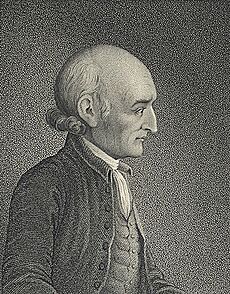
George Wythe, America's first law professor
George Wythe is known as a pioneer in American legal education. He studied at the college but had to leave because he couldn't afford it. Jefferson, who called Wythe "my second father," studied with Wythe from 1762 to 1767. By 1779, Wythe became the first law professor in America at the college. His other students included famous figures like Henry Clay and John Marshall.
The college also educated four U.S. Supreme Court Justices and other important government members.
Changes After the Revolution
During the American Revolution, Virginia established religious freedom and the idea of separating church and government. The English government and the Church of England lost their power. People still practiced their religion, but the church's structure changed. It became what is now called The Episcopal Church in the United States.
Reverend James Madison, a cousin of future U.S. President James Madison, was a key figure in this change. He and Thomas Jefferson helped the College of William & Mary adapt. The college became a university by adding graduate schools in law and medicine.
Reverend James Madison was a teacher at William & Mary when the Revolution began. He organized his students into a local army group. In 1777, the college president, Reverend John Camm, was removed because he supported the British. Reverend Madison became the 8th president of the college in October 1777. He was the first president after the college separated from England.
As president, Reverend Madison worked with Virginia's new leaders, especially Jefferson. They reorganized the college. This included closing the Divinity School and the Indian School, also known as the Brafferton School. The Indian School was meant to educate Native American youth. However, Native American parents often didn't want to send their children. Many students were captive children from enemy tribes. The school was not very successful in converting Native Americans to Christianity. But it did help educate interpreters who could help with communication. The Revolutionary War stopped the school's funding from England. By 1779, the Brafferton School closed permanently. However, the building, known as "The Brafferton," is still an important building on campus.
In June 1781, during the war, British troops used the president's house as their headquarters. The college closed for a few months. The British surrendered at Yorktown on October 19 of that year.
Before the Civil War (1776–1861)
After the colonies declared independence in 1776, the College of William & Mary officially cut ties with England. However, the college is still proud of its connection to British history. It keeps a relationship with the British monarchy. Even former Prime Minister Margaret Thatcher served as a Chancellor of the college. Queen Elizabeth II visited the college twice.
In 1842, former students formed the Society of the Alumni. This is now the sixth oldest alumni group in the United States. In 1859, a big fire damaged the college. The Alumni House is one of the few original buildings left from before the Civil War. Other important ones are the Wren Building, the President's House, and the Brafferton.
Slavery and William & Mary
From its start in 1693 until the Civil War, the college owned and used enslaved people. Some professors even argued that slavery was a good thing. President Thomas Roderick Dew (who led the college from 1836–1846) was a main leader of the pro-slavery movement. He helped stop efforts to free all enslaved people in Virginia after Nat Turner's revolt in 1831.
In 2009, the college's leaders admitted that the university had used enslaved labor. They also admitted that the college did not stand against segregation during the Jim Crow Era. With their support, the Lemon Project: A Journey of Reconciliation was started. (Lemon was the name of an enslaved person owned by the college.) The Lemon Project tries to fix the wrongs done to African Americans by William & Mary. It holds an annual meeting to discuss the past experiences of African Americans at the college.
Civil War and Becoming a State School
When the American Civil War (1861–1865) began, many students joined the Confederate Army. So, on May 10, 1861, the teachers decided to close the college. The College Building was used as a barracks for soldiers and later as a hospital. First, Confederate soldiers used it, then Union soldiers. The Battle of Williamsburg happened nearby in May 1862. The city was taken by Union forces the next day. The Brafferton building was used as living quarters for the Union commander. On September 9, 1862, some Union soldiers set fire to the College Building. They supposedly did this to stop Confederate snipers from hiding there. The city was badly damaged during the Union occupation, which lasted until September 1865.
After the Union won the Civil War, Virginia was very poor. The college's 16th president, Benjamin Stoddert Ewell, could only reopen the school in 1869 by using his own money. He asked the U.S. government for money to fix the war damage, but it took a long time. His request was finally granted in 1893. But before that, the college struggled and closed in 1881 because it ran out of money.
There's a story that for seven years, between 1881 and 1888, President Ewell would wake up every morning and ring the college bell. He did this so people could never say that William & Mary had stopped its mission to educate young men.
In 1888, William & Mary reopened. The state of Virginia gave $10,000 to make it a state school for training white men to be teachers. Dr. Ewell, who was very old and had spent much of his own money, was finally able to retire. His beloved college was now on a new, more stable path.
20th Century: Coeducation and Teacher Training
Lyon Gardiner Tyler (1853–1935) became the 17th president after President Ewell retired. Tyler started to make the college a modern institution. He brought together a group of teachers known as the "Seven Wise Men." In 1906, the state government officially took over the college's land. Since then, it has been supported by public funds.
In 1918, William & Mary was one of the first universities in Virginia to become coeducational. This means it started admitting women as well as men. During this time, the number of students grew from 104 in 1889 to 1269 by 1932. Tyler retired as president in 1919.
J.A.C. Chandler became the 18th president. He continued and greatly expanded the changes started by Dr. Tyler. Dr. Chandler was a historian and had worked in education before coming to William & Mary. He was very creative and energetic. He also helped get land for the first Catholic church in Williamsburg. This church later became the National Shrine of Our Lady of Walsingham.
Dr. Chandler also helped bring Reverend Dr. W.A.R. Goodwin to the college. Dr. Goodwin was interested in restoring historic buildings in Williamsburg. In 1926, the dedication of the college's new Phi Beta Kappa Hall gave Dr. Goodwin a chance to meet John D. Rockefeller Jr. and his wife, Abby Aldrich Rockefeller. Dr. Goodwin shared his dream of restoring the "birthplace of America's democracy." John and Abby Rockefeller became a big part of this dream, which became Colonial Williamsburg.
Even though most of the restoration became a separate project, the college and Colonial Williamsburg are still very close. The Wren Building, the President's House, and the Brafferton were restored between 1928 and 1932. This greatly helped the college.
Dr. Chandler also focused on training teachers for public schools. Despite the Great Depression and his own health problems, his biggest achievement was the School of Education. This school has a long tradition of educating many of Virginia's public school teachers.
During Dr. Chandler's 14 years, the number of full-time teachers grew to over 100. The student body grew from 300 to over 1200, even during the Depression. In 1930, William & Mary opened a branch in Norfolk, Virginia. This branch later became Old Dominion University. Other branches followed across the state. The college has a good relationship with the Virginia government, which helps fund public education programs. The School of Education continues to train teachers and other school staff. Many teachers who use these services earn advanced degrees and become leaders in schools.
Mid-1930s Through World War II
William and Mary had a short-lived "Air School" under Dr. Chandler. It had two facilities for aviation. This program ended due to the Great Depression, Dr. Chandler's health, and changes in aviation technology. Aviation quickly became more focused on military and commercial uses.
Building continued under the college's 19th president, John Stewart Bryan. In 1935, the Sunken Gardens were built west of the Wren Building. Their design is similar to a garden at Chelsea Hospital in London.
After World War II to Today
Queen Elizabeth II and Prince Philip, Duke of Edinburgh visited the college on October 16, 1957. The Queen spoke from the balcony of the Wren Building. She visited again on May 4, 2007, for the 400th anniversary of the Jamestown settlement.
In 1974, Jay Winston Johns left Ash Lawn-Highland to the college. This was the historic home of alumnus and U.S. President James Monroe. The college restored this home near Charlottesville and opened it to the public.
In 2006, President Gene Nichol made a decision about a cross in the Wren Building chapel. He removed it because of concerns about religious diversity. After many people on campus and alumni protested, the cross was returned to the chapel. Today, the cross is used in religious services by the Episcopal and Catholic campus ministries.
In 2018, Katherine Rowe became the first female president of the college in 325 years. During the 2019-2020 COVID-19 pandemic, the college moved all classes online in March 2020. Students were asked to stay off campus for the rest of the semester.
After the George Floyd protests in 2020 and 2021, several buildings and halls were renamed. Maury Hall was renamed York River Hall. Trinkle Hall became Unity Hall. In April 2021, three more buildings were renamed: Morton Hall became John E. Boswell Hall (named for an LGBT advocate and alum). Taliaferro Hall became Hulon L. Willis Sr. Hall (Hulon Willis Sr. was the first Black student at the college). Tyler Hall returned to its original name, Chancellors’ Hall.
Sir Christopher Wren Building
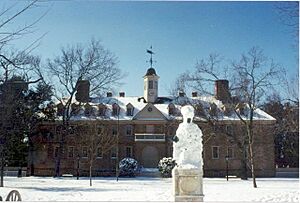
The Wren Building with a snow-covered statute of Lord Botetourt
The building officially called the "Sir Christopher Wren Building" got its name in 1931. It was named to honor the English architect Sir Christopher Wren. A history book from 1724 said that Wren designed the building in 1699. But little is known about how it looked because it burned down a few years after it was finished. We don't know for sure if Sir Christopher Wren actually designed the building, as he never came to North America. Today's Wren Building is based on the design of the building that replaced it in 1716.
In the early 20th century, Reverend Dr. W.A.R. Goodwin and John D. Rockefeller Jr. started a huge project to rebuild and restore Williamsburg. This project became Colonial Williamsburg. The Wren Building was the first major building to be restored as part of this project. Architects rebuilt the building to look like its second version (from 1715–1859). They used an old drawing and plans that Thomas Jefferson drew in 1772.
Two other buildings near the Wren Building complete a triangle called "Ancient Campus." These are the Brafferton (built in 1723, originally for the Indian School, now offices) and the President's House (built in 1732).
The Wren Building is the oldest educational building in the United States that has been used continuously. In colonial times, it was simply called "The College." This is because, in the early years, the entire College of William & Mary was just this one building. All the students (only males back then) lived, ate, studied, and learned inside its walls.
College Firsts
William & Mary is the second-oldest college in the United States, founded in 1693. Harvard is the oldest.
The college was the first to teach political economy, which is about how countries manage their money and resources. Adam Smith's book Wealth of Nations was a required textbook. In 1779, William & Mary became the first college in America to become a university. It did this by starting law and medicine departments. It was also the first college to have a professor of modern languages. Chemistry was taught starting in the 1800s.
Thomas Jefferson, who later founded the University of Virginia, helped change the college's courses. He wanted to make the college less focused on religion. Jefferson also helped the college adopt the nation's first system where students judged academic honesty.
At Jefferson's request, the college appointed his friend and teacher George Wythe as the first law professor in America in 1779. John Marshall, who later became the Chief Justice of the U.S. Supreme Court, was one of Wythe's students. The college's Marshall-Wythe School of Law is the oldest law school in the United States.
By 1779, with new money and the addition of law and medicine schools, the "College" officially became a "university." Even so, it kept its original name from the 1693 Royal Charter.
Secret Societies
The College of William and Mary has many secret societies. It is home to the nation's first academic secret society, the Flat Hat Club. Many societies disappeared during the Civil War but were brought back in the 20th Century. Some known secret societies at the college today include the Seven Society (Order of the Crown and Dagger), Wren Society, Bishop James Madison Society, Flat Hat Club, Alpha Club, The Society, 13 Club, Eagle J, the Spades, and W Society. These groups often focus on helping the college through secret donations.
John Heath and William Short (Class of 1779) started the Phi Beta Kappa academic honor society at William & Mary on December 5, 1776. It began as a secret group for literature and philosophy. More chapters were soon started at Yale and Harvard. Now there are 270 chapters across the country. Alumni John Marshall and Bushrod Washington were early members of Phi Beta Kappa.
See also
- List of The College of William & Mary presidents

